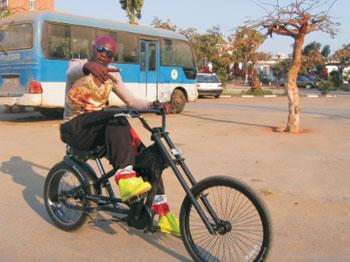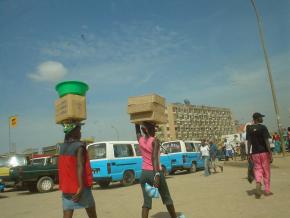KUDURO, Luanda's beat
 Sebem in Jorge António’s documentary, Kuduro, Fogo no Musseke, Luanda, 2007.
Sebem in Jorge António’s documentary, Kuduro, Fogo no Musseke, Luanda, 2007.
Kuduro is a musical and a dance genre which started life in Luanda in the early 90s. Its origins range from Angolan Semba to Congolese Zouk, Caribbean Soca and American Techno, Hip Hop and House. This mega rhythmic fusion is combined with lyrics taken from Luanda’s urban oral tradition: slang formed in the fusion between Kimbundo and Portuguese, as well as Lingala and English.
Just as important as the music, Kuduro dance, according to one of its creators, Tony Mado, was inspired by a movie where the Belgian actor, Jean Claude Van Damme dances drunk. Movements from traditional Angolan dances are merged with Break Dance and Popping, in dramatic individual or group performances. In spite of being based on common movements, individuality is highly valued in Kuduro dance, with each dancer foregrounding his own gestures and making use of strong facial expressions.
The city’s pulsating rhythm, in its economic, political and social aspects, is reflected in this urban cultural phenomenon with its rapid rhythmic base: not only in formal terms but also in the celerity with which this genre re-invents itself daily, conjuring up new words, rhythms and movements.
Kuduro sprang up Luanda’s musseques (shanty towns) and spread rapidly through the Kandongueiros (street vendors or hawkers). New music appears on a daily basis, feeding Luanda’s vocabulary with new expressions, new beats and new moves. This frenetic creation of urban languages plays an important role in today’s Luanda, especially among the younger city dwellers.
According to Angolan writer, José Eduardo Agualusa: “Maybe never, in the entire history of Angola, has there been such a strongly expressed cultural phenomenon.”1
For that reason, Kuduro has stirred up some controversy in Angolan society. Some criticize its musical form because it avoids the traditional Angolan melodies, others dislike its language and aggressive messages, associating Kuduro with Musseque gang violence, and there are those disturbed by its caustic words and social criticism. One example is a Dog Murras song, Angola bwé de caras:
Angola of oil, diamonds and much timber
Angola of malaria, typhoid fever, diarrhoea
Angola of the talé boss, who eats alone with much ambition
Angola of the soda, blindfolding corruption
Angola of the heirs, doing nothing but much dough
Angola of the honest old man, who works a lot for nothing
Quoting José Eduardo Agualusa again: “One of the most interesting things is the way it has been growing; not only on the fringes of the established powers but, in many cases, against them”2.
Luanda’s musseques, resistance, innovation and creativity spaces
Kuduro arose in Luanda’s musseques, where it is produced and circulated. Recordable CDs are sold by the zungueiros (street vendors) in the city’s streets and internationalized through the Internet, especially on youtube and myspace.
“The musseques were the crucible where popular urban Angolan music was created, and within and around it a sense of nation.“ (Moorman, 2008: 28).
There, in the musseques, live most of the city dwellers: a city characterized by an explosive growth at the end of World War II which, with different features and effects, increased during Angola’s civil war.
“[The] musseques are a complicated cosmopolitan social space, where the national imaginary was made and remade as the guerrilla war raged on in the distance. More than just a stop on the way to modernity or urbanization, the musseques were a place where various generations, classes, ethnic groups, races, and genders met and imagined a new world for themselves in the practices of everyday life.” (Moorman, 2008: 55)3.
However, the war which began in 1961 against the colonial regime worsened internal conflicts (strongly supported in the international political context of the Cold War) that eventually gave way to a struggle for power between the three main political forces in Angola, namely MPLA, UNITA and FNLA, after the Carnation Revolution in Portugal in April 1974 and the advent of independence. The Declaration of Independence made in Luanda in 1975 by the MPLA, without the agreement of the other parties, led to a civil war that only ended in 2002, with the death of UNITA’s leader, Jonas Savimbi.
With the fall of the Socialist Bloc and the end of the Cold War, there were a series of political and economic reforms in Angola, namely the inauguration of a multiparty democratic system and a free market economy, which began in the 90’s. These profound and rapid changes, associated in Luanda’s case with a geometrical demographic increment, radically transformed the city. In 1975, Luanda’s population was about 700 thousand inhabitants and, in 2007, 4 million: ¼ of the country’s total population. (UNO evaluation_ Urban Agglomerations 2007)
“The suburbs have grown non stop, become denser, with many new people coming from many different places and endless construction sprawling into the nearby fields: flurry, relationships, traffic, ebullient life” (Oppenheimer and Raposo, 2007: 106)
This is the context where Kuduro was born: the dense and intense capital, overcrowded and chaotic, of a country immersed in a civil war, which experienced the constraints of a single party political system and then embraced political and economic liberalization. The State reduced its direct interference in cultural production (specifically, it stopped supporting musical bands) in a period of openness to new influences, new freedoms, new technologies.
 The 90s international music scene brought the electronic wave, and Luanda listened to Hip Hop, House Music, Techno, Rap, etc. Hip Hop, which is a major influence on Kuduro, was born in the Bronx, New York, at the end of the 70s, as a social protest made by a marginalized youth, mainly immigrants and afro descendants. The impact this movement had on the young Angolans living in musseques was hardly surprising:
The 90s international music scene brought the electronic wave, and Luanda listened to Hip Hop, House Music, Techno, Rap, etc. Hip Hop, which is a major influence on Kuduro, was born in the Bronx, New York, at the end of the 70s, as a social protest made by a marginalized youth, mainly immigrants and afro descendants. The impact this movement had on the young Angolans living in musseques was hardly surprising:
“The peripheral societies have always been open to Western cultural influences, and now more than ever. The idea that these are enclosed spaces – ethnically pure, culturally traditional and untouched by modernity ruptures - it’s a Western fantasy about them, kept by the West, that tends to love its natives as pure and its exotic places as untouched” (Hall, 2003: 79-80)
Hip Hop groups appeared in Luanda, some more underground and with a larger social consciousness4, whilst others were more commercial, aggressive and sexist, submerged in the usual consumerist paraphernalia (clothing labels, etc). But in spite of this major influence, Kuduro is not Hip Hop. It’s Luanda’s unique genre, spontaneous and unpredictable, the result of a merging between local and global: what we could call a Glocal culture.
Responding to some criticism of the Western hegemony in local cultures, Kuduro is a good example of how the tension generated when globalization meets local culture can produce new facts, new dynamics, and a new affirmation. As Stuart Hall proposes, there can be a new reading of the post-modern:
“Instead of thinking of the global as a substitute for the local, one should think of a new articulation between global and local” (Hall, 2003: 77)
Kuduro: from the musseques to the Kandongueiros, from youtube to the world
It’s impossible to overestimate the importance of new technologies, which have allowed for the rapid diffusion and proliferation of Kuduro not only nationally but on European dance floors and amongst Djs and musicians around the world5
The last two decades of the 20th century were characterized by an increasing amount of information and the speed of its circulation. These new possibilities have opened up a fundamental path in the freedom to create and a greater autonomy in the dynamics of production, commoditisation and diffusion. Rivalling the usual market strategies of the music industry and escaping state and institutional control, these peripheral phenomena can guarantee not only nationwide diffusion but also internationalization that, in Kuduro’s case, has brought about a certain legitimation: from informality to the mainstream.
Regardless of the Angolan population’s reaction to Kuduro (whether positive or negative), it has an essential role in the reconstruction and questioning of today’s society. If, as Marissa Moorman says, during the struggle for independence the musseques formed both the national imaginary and the main resistance against the Colonial State; in today’s Luanda, these places are still the pillars of social expression and active criticism of contemporary tensions.
Quoting the Angolan musician, Paulo Flores6:
“Kuduro represents the voice of a new Angola; an Angola that wants to be heard and, more than that, has to be heard. Angola of the youth, Angola of the neighbourhoods, of the periphery… Angola has a message to send, to tell. It seems to me that the only way for us to know ourselves is having that space to listen to others.”
Bibliography:
Amaral, Ilídio (1968), Luanda (Estudo de Geografia Urbana), Lisbon, Memórias da Junta de Investigações do Ultramar, 2ª ser. Nº 53.
António, Jorge, Kuduro, Fogo no Musseke: Produção Mukixe and Lx Filmes, 2007, video documentary (DVD) (60 min.).
Bertrand, Monique (1998), Villes africaines, modernités en question, Tiers-Monde, volume 39, 156, pp. 885-904.
Conceição, Simone Ribeiro (2008), “Movimento Kudurista: uma nova linguagem na Expressão Cultural Urbana de Angola”, comunicação apresentada no XI Congresso Internacional da ABRALIC Tessituras, Interações, Convergências, Congress held at the University of São Paulo, 13th to 17th July 2008, São Paulo, Brazil.
Hall, Stuart (2003), A identidade cultural da pós-modernidade, Rio de Janeiro, DP&A Editora, p. 07-22.
Lança, Marta (2007), Luanda está a mexer! Hip Hop Underground em Angola, Jornal Público, Lisbon, 06.07.2007.
Magalhães, Ana and Inês Gonçalves (2009), Moderno Tropical – Arquitectura em Angola e Moçambique, 1948-1975, Lisbon, Edições Tinta-da-China.
Mbembe, Achille (2001), “Formas Africanas da Escrita de Si”, artigos (online), available at: www.artafrica.info
__________, and Sarah Nuttall (2004), “Writing the World from an African Metropolis”, Public Culture, 16 (3) pp. 347-372.
Moorman, Marissa (2008) Intonations: a social history of music and nation in Luanda, Angola, from 1945 to recent times, Ohio, Ohio University Press.
Nogueira, Nok de (2009), “História do kuduro”, (online), available at:
http://kuduro-de-angola.blogspot.com/
Servant, Jean-Christophe (2008), “Angola: o kuduro restaura a consciência de classe”, Le Monde Diplomatique – Edição Portuguesa.
Oppenheimer, Jochen and Isabel Raposo [coord.] (2007), Subúrbios de Luanda e Maputo, Lisbon, Edições Colibri and CESA.
Ribeiro, António Pinto (2009), À Procura de Escala. Cinco exercícios disciplinados sobre cultura contemporânea, Lisbon, Edições Cotovia.
Webgraphy:
Natalia Viana, 2009, Kuduro, a voz da periferia de Angola:
www.operamundi.com.br/reportagens_especiais_ver.php?idConteudo=1517
Ikonoklasta, 2010, Um dia da gravação, no Santuário, Sambizanga. Luanda:
http://www.youtube.com/watch?v=fBdU5noNmNI
Richardson, John E, 2002, Towards a theory of Hip-Hop http://www.vanguard-online.co.uk/archive/politicsandculture/roots02c.doc/roots2c.doc
https://myspace.com/saborosafofa
http://kuduro-sound-system.blogspot.com
www.myspace.com/burakasomsistema
- 1. Part 2: Kuduro, Angola’s peripheral voice, 10/10/2009, Natalia Viana, São Paulo www.operamundi.com.br/reportagens_especiais_ver.php?idConteudo=1517
- 2. Part 2: Kuduro, Angola’s peripheral voice, 10/10/2009, Natalia Viana, São Paulo www.operamundi.com.br/reportagens_especiais_ver.php?idConteudo=1517
- 3. Musically speaking, the most emblematic example of this was the band N’Gola Ritmos, whose main members Liceu Vieira Dias, Amadeu Amorim and Zé Maria dos Santos were arrested in 1959, accused of conspiracy against the Portuguese colonial authorities.
- 4. Philosophy student, Mc Kapa, became a resistance symbol in Angola after the assassination of a 27 year old student by the presidential guards, for singing a song from Kapa’s first album: Trincheira de Ideias (ou Petróleo Bruto para os piratas), 2002.
- 5. Buraka Som Sistema, especially their Sound of Kuduro song (from the Black Diamond album, 2007) with participation by the British artist M.I.A. had a great success among Angolan Kuduristas: DJ Znobia, Puto Prata and Saborosa.Also Murras, Pai Diesel, Tony Amado, Gata Agressiva, among others take part in Frederic Galliano’s most recent album Kuduro Sound System.
- 6. In Jorge António’s documentary, Kuduro, Fogo no Musseke, Luanda, 2007.